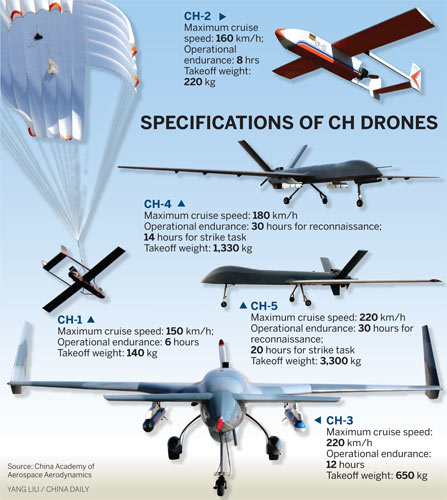A number of foreign nations are awaiting delivery of China’s CH series military drones, one of the country’s most popular products on the international arms market.
The drone family, bearing the name Cai Hong, which means rainbow in Chinese, is considered by experts to be among the most lethal drones on the planet. The newest and largest capacity combat drone in the series, the CH-5, is awaiting government approval for export.
“The total value of contracts we signed in 2015 could definitely be one of the highest in terms of armed drone deals made last year on the international market,” Shi Wen, chief drone designer at the China Academy of Aerospace Aerodynamics in Beijing, told China Daily in an exclusive interview. He did not provide a figure.
The academy, part of China Aerospace Science and Technology Corp, is one of China’s largest military drone developers.
Its CH series drones have been sold to 20 military users from more than 10 foreign countries and are the largest military drone family that China has exported, Shi said.
The early models, CH-1 and CH-2, are small, unarmed reconnaissance craft that have a proven record in locating and monitoring targets.
The larger ones – the CH-3 midrange combat and reconnaissance drone and CH-4 mid-altitude, high-endurance armed drone – immediately attracted buyers seeking a powerful, affordable unmanned combat aircraft.
“Our best-selling type so far is the CH-3, while the CH-4 has also received many orders,” Shi said, adding that many more countries have expressed a “strong desire” to buy CH drones, but have yet to do so because of their sluggish economies.
Shi declined to disclose which countries have purchased the CH series, only revealing the academy’s most valuable sale was worth “hundreds of millions of US dollars”.
China Space News reported in January last year that Shi’s academy would deliver about 200 CH drones to domestic and foreign users. Earlier reports by Western media cited Egypt, Saudi Arabia, Pakistan, Nigeria and the United Arab Emirates as known buyers of CH drones.
The first contract to export CH drones was signed in 2003 and fulfilled in 2004, when a South Asian country bought several CH-1s, Shi said.
Since then, the buyer has become a loyal user of CH series drones and is negotiating the purchase of some CH-4s, he said.

‘What users need’
“Foreign militaries bought our products because, first, our drones have strong capabilities and are easy to use.
If you can play flight simulation games, then you can use our drones. Second, we understand what users really need,” Shi said.
Compared with their competitors, the CH drones have bigger payloads, which means they can carry more weapons, and a higher level of automation, so only a small number of ground controllers are needed, he said.
The academy’s designers researched the requirements of potential users and decided their military drones should operate at an altitude above 5,000 meters.
“We believe most of our users would use the drones to patrol borders, reconnoiter targets and hit terrorists or insurgents, who usually own small anti-aircraft weapons capable of striking planes flying about 3,000 meters above the ground. Therefore the 5,000-meter altitude is high enough to ensure the safety of our drones,” Shi said.
The CH-3 and CH-4 are capable of firing missiles from about 10 km away from a target and can stay in the air for more than 10 hours. They also have a long life span, Shi said.
“The CH-3 has a designed operational span of 5,000 hours. It is very good at long-duration, continual operation.
One of our clients in Africa uses each of its CH-3s about 100 hours on average each month. It once used a CH-3 for about 300 hours in a single month, and the drone had no problem at all,” he said.
Larger capacity
The latest and heaviest drone in the CH family is the CH-5 combat and reconnaissance drone, which has prompted keen interest among foreign clients, even though it just made its first flight in August, Shi said.
The CH-5 is made of composite materials and has a wingspan of 21 meters. It can stay in the air for up to 30 hours and operate at an altitude of up to five km. It can fly at speeds ranging from 160 to 220 km/h and operate 2,000 km from ground control if connected via satellite.
While previous armed drones typically had a maximum takeoff weight of less than 1,500 kg, the CH-5 is able to fly with a weight of 3,300 kg, according to the academy’s specifications.
The larger capacity enables the drone to have more reconnaissance devices so it can detect a given target within an 80 km radius, said Lan Wenbo, a chief engineer.
Shi said the CH-5 is capable of launching various air-to-surface missiles and laser-guided bombs and will be able to conduct early-warning operations after an upgrade.
“We have submitted an application for the government’s approval for its export,” he said.
World’s most famous military drones
– US General Atomics MQ-1 Predator
– US General Atomics MQ-9 Reaper
– US Northrop Grumman RQ-4 Global Hawk
– Israel’s Elbit Hermes 450
– Israel’s Aerospace Industries Heron
– Aviation Industry Corp of China’s Wing Loong I
– China Aerospace Science and Technology Corp’s CH-4





